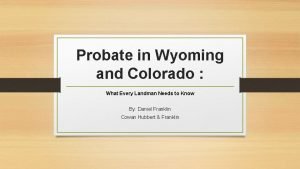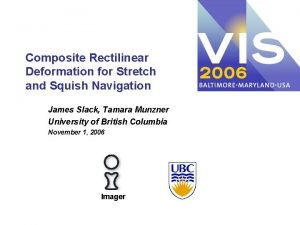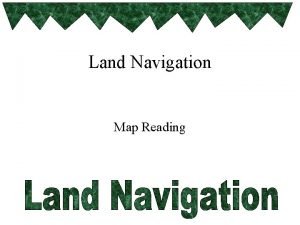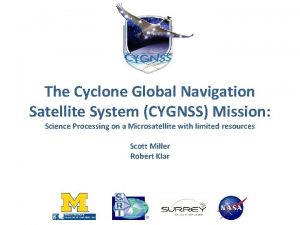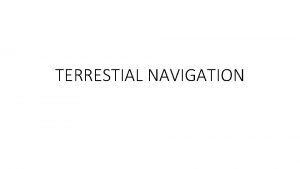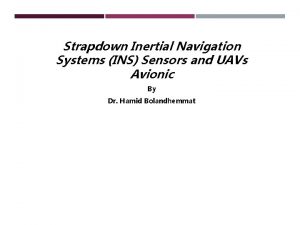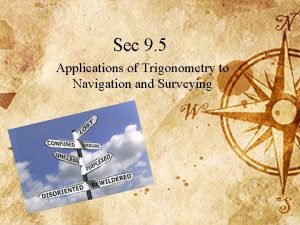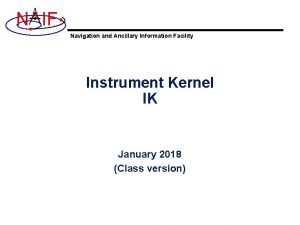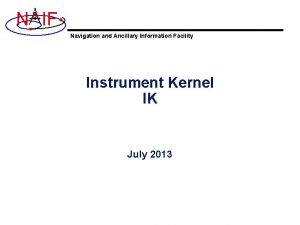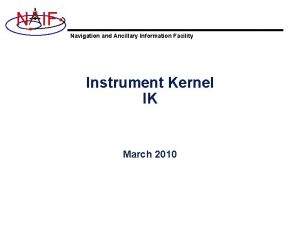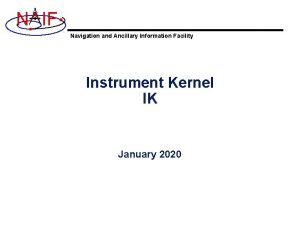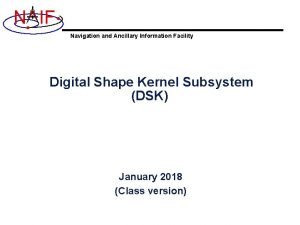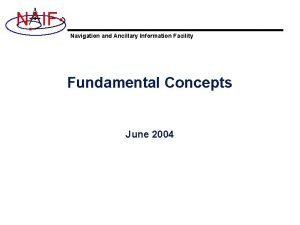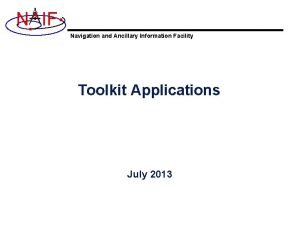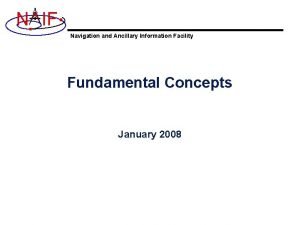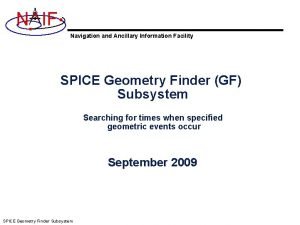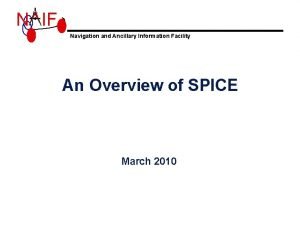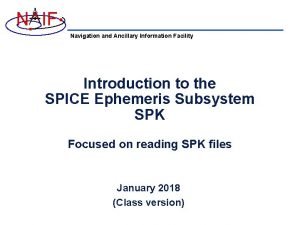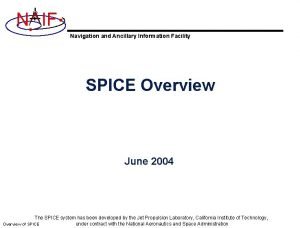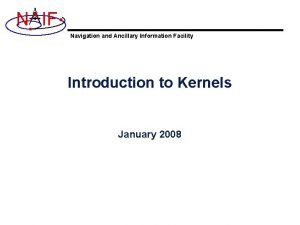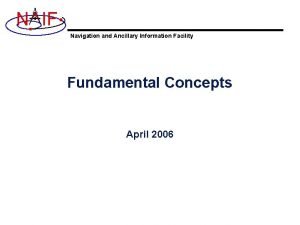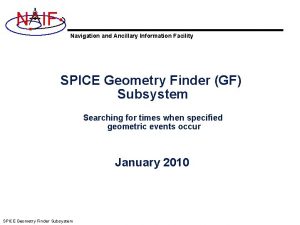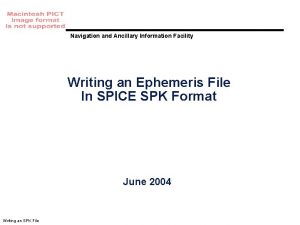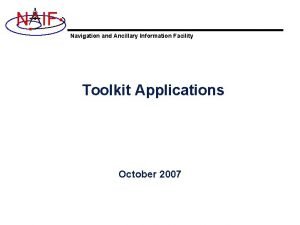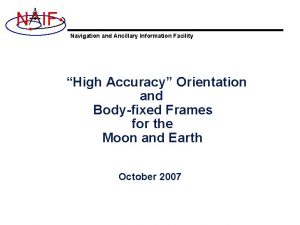N IF Navigation and Ancillary Information Facility Instrument


























- Slides: 26

N IF Navigation and Ancillary Information Facility Instrument Kernel IK March 2006

N IF Purpose Navigation and Ancillary Information Facility • The Instrument kernel serves as a repository for instrument specific information that may be useful within the SPICE context. – Specifications for an instrument’s field-of-view size, shape, and orientation. – Internal instrument timing parameters and other data relating to SPICE computations might also be placed in an I-kernel. • Note: Instrument mounting alignment data are most often specified in a mission frames kernel (FK). • The IK is a SPICE text kernel. Instrument Kernels 2

N IF I-Kernel Structure Navigation and Ancillary Information Facility • The format and structure of a typical I-Kernel is: KPL/IK Comments describing the keywords and values to follow, as well as any other pertinent information. begindata Keyword = Value Assignments begintext More descriptive comments. begindata More Keyword = Value Assignments begintext More comments, followed by more data, etc … Instrument Kernels 3

N IF I-Kernel Contents (1) Navigation and Ancillary Information Facility • The requirements on keywords in an IK are the following: – Keywords must begin with INS[#], where [#] is replaced with the NAIF instrument ID code (which is a negative number). – The total length of the keyword must be less than 32 characters. – Keywords are case-sensitive. (Keyword != KEYWORD) • Some examples of IK keywords: – MGS MOC NA focal length: – MEX HRSC SRC pixel angular size: – MEX ASPERA NPI number of sectors: INS-94031_FOCAL_LENGTH INS-41220_IFOV INS-41130_NUMBER_OF_SECTORS • The SPICE toolkit does not require any specific keywords to be present in IK – One exception is a set of keywords defining an instrument’s FOV if the GETFOV routine is planned to be used to retrieve the FOV attributes » Keywords required by GETFOV will be covered later in this tutorial Instrument Kernels 4

N IF I-Kernel Contents (2) Navigation and Ancillary Information Facility • IKs usually contain extensive comments including – – – Instrument overview Reference source(s) for the data included in the IK Names/IDs assigned to the instrument and its parts Explanation of each keyword included in the file Description of the FOV and detector layout Sometimes descriptions of the algorithms in which parameters provided in the IK are used, and even fragments of source code implementing these algorithms » For example optical distortion models or timing algorithms • This documentation exists primarily to assist users in integrating I-Kernel data into their applications – One needs to know the keyword name to get its value from the loaded IK data – One needs to know what that value means in order to use it Instrument Kernels 5

N IF I-Kernel Interface Routines Navigation and Ancillary Information Facility • As with any SPICE kernel, IK files are loaded using FURNSH CALL FURNSH ( ’ik_file_name. ti’ ) • Knowing the name and type (DP, integer, or character) of a keyword of interest, the value of that keyword can be retrieved using G*POOL routines CALL GDPOOL ( NAME, START, ROOM, N, VALUES, FOUND ) CALL GIPOOL ( NAME, START, ROOM, N, VALUES, FOUND ) CALL GCPOOL ( NAME, START, ROOM, N, VALUES, FOUND ) • When an instrument’s FOV is defined in the IK using a special set of keywords discussed later in this tutorial, the FOV shape, reference frame, boresight vector, and boundary vectors can be retrieved by calling the GETFOV routine CALL GETFOV ( INSTID, ROOM, SHAPE, FRAME, BSIGHT, N, BOUNDS) Instrument Kernels 6

N IF FOV Definition Keywords (1) Navigation and Ancillary Information Facility • The following keywords defining FOV attributes for the instrument with NAIF ID (#) must be present in the IK for GETFOV to work: – Keyword defining shape of the FOV INS#_FOV_SHAPE = 'CIRCLE' or 'ELLIPSE' or 'RECTANGLE' or 'POLYGON' – Keyword defining reference frame with respect to which the boresight vector and FOV boundary vectors are specified INS#_FOV_FRAME = 'frame name' – Keyword defining the boresight vector INS#_FOV_BORESIGHT = ( X, Y, Z ) Instrument Kernels 7

N IF FOV Definition Keywords (2) Navigation and Ancillary Information Facility – Keyword(s) defining FOV boundary vectors, in either of two ways » By specifying boundary vectors explicitly INS#_FOV_CLASS_SPEC = 'CORNERS' (optional) INS#_FOV_BOUNDARY_CORNERS = ( X(1), Y(1), Z(1), … … … X(n), Y(n), Z(n) ) » By providing half angular extents of the FOV (possible only for circular, elliptical or rectangular FOVs) INS#_FOV_CLASS_SPEC INS#_FOV_REF_VECTOR INS#_FOV_REF_ANGLE INS#_FOV_CROSS_ANGLE INS#_FOV_ANGLE_UNITS Instrument Kernels = = = 'ANGLES' ( X, Y, Z ) halfangle 1 halfangle 2 'DEGREES' or 'RADIANS’ or … 8

N IF FOV Definition Keywords (3) Navigation and Ancillary Information Facility • Neither boresight nor reference vectors have to be coaligned with one of the FOV frame’s axes – But for convenience they are frequently defined to be along one of the axes • Neither boresight nor corner or reference vectors have to be unit vectors – But they frequently are defined as unit vectors • When FOV is specified using the half angular extents method, boresight and reference vectors have to be linearly independent but they don’t have to be perpendicular – But for convenience the reference vector is usually picked to be normal to the boresight • Half angular extents for a rectangular FOV specify the angles between the boresight and the FOV sides, i. e. they are for the middle of the FOV Instrument Kernels 9

N IF Circular Field of View Navigation and Ancillary Information Facility Consider an instrument with a circular field of view. Y 14. 03 O X Y Subtended field of view angle Boundary Corner Vector (0, 1, 4) Angular Size Z 14. 03 = arc tan (1/4) X (0, 0, 0) Boresight Vector Instrument Kernels 10

N IF Circular FOV Definition Navigation and Ancillary Information Facility The following sets of keywords and values describe this circular field of view: Specifying boundary vectors explicitly: INS-11111_FOV_SHAPE INS-11111_FOV_FRAME INS-11111_FOV_BORESIGHT INS-11111_FOV_BOUNDARY_CORNERS = = 'CIRCLE' 'FRAME_FOR_INS-11111' ( 0. 0 1. 0 ) ( 0. 0 1. 0 4. 0 ) Specifying half angular extents of the FOV: INS-11111_FOV_SHAPE INS-11111_FOV_FRAME INS-11111_FOV_BORESIGHT INS-11111_FOV_CLASS_SPEC INS-11111_FOV_REF_VECTOR INS-11111_FOV_REF_ANGLE INS-11111_FOV_ANGLE_UNITS Instrument Kernels = = = = 'CIRCLE' 'FRAME_FOR_INS-11111' ( 0. 0 1. 0 ) 'ANGLES' ( 0. 0 1. 0 0. 0 ) 14. 03624347 'DEGREES' 11

N IF Elliptical Field of View Navigation and Ancillary Information Facility Consider an instrument with an elliptical field of view. Y 14. 03 O Y 26. 57 O X Subtended field of view angle 14. 03 = arc tan (1/4) 26. 57 = arc tan (2/4) Boundary Corner Vectors (0, 1, 4) Z X (2, 0, 4) (0, 0, 0) Boresight Vector Instrument Kernels 12

N IF Elliptical FOV Definition Navigation and Ancillary Information Facility The following sets of keywords and values describe this elliptical field of view: Specifying boundary vectors explicitly: INS-22222_FOV_SHAPE INS-22222_FOV_FRAME INS-22222_FOV_BORESIGHT INS-22222_FOV_BOUNDARY_CORNERS = = 'ELLIPSE' 'FRAME_FOR_INS-22222' ( 0. 0 1. 0 ) ( 0. 0 1. 0 4. 0 2. 0 0. 0 4. 0 ) Specifying half angular extents of the FOV: INS-22222_FOV_SHAPE INS-22222_FOV_FRAME INS-22222_FOV_BORESIGHT INS-22222_FOV_CLASS_SPEC INS-22222_FOV_REF_VECTOR INS-22222_FOV_REF_ANGLE INS-22222_FOV_CROSS_ANGLE INS-22222_FOV_ANGLE_UNITS Instrument Kernels = = = = 'ELLIPSE' 'FRAME_FOR_INS-22222' ( 0. 0 1. 0 ) 'ANGLES' ( 0. 0 1. 0 0. 0 ) 14. 03624347 26. 56505118 'DEGREES' 13

N IF Rectangular Field of View Navigation and Ancillary Information Facility Consider an instrument with a rectangular field of view. Y Y 14. 03 O 26. 57 O X Subtended field of view angle 14. 03 = arc tan (1/4) 26. 57 = arc tan (2/4) Boundary Corner Vectors (2, 1, 4) (-2, 1, 4) Z X (0, 0, 0) (2, -1, 4) (-2, -1, 4) Boresight Vector Instrument Kernels 14

N IF Rectangular FOV Definition Navigation and Ancillary Information Facility The following sets of keywords and values describe this rectangular field of view: Specifying boundary vectors explicitly: INS-33333_FOV_SHAPE INS-33333_FOV_FRAME INS-33333_FOV_BORESIGHT INS-33333_FOV_BOUNDARY_CORNERS = = ’RECTANGLE' 'FRAME_FOR_INS-33333' ( 0. 0 1. 0 ) ( 2. 0 1. 0 4. 0 -2. 0 -1. 0 4. 0 ) Specifying half angular extents of the FOV: INS-33333_FOV_SHAPE INS-33333_FOV_FRAME INS-33333_FOV_BORESIGHT INS-33333_FOV_CLASS_SPEC INS-33333_FOV_REF_VECTOR INS-33333_FOV_REF_ANGLE INS-33333_FOV_CROSS_ANGLE INS-33333_FOV_ANGLE_UNITS Instrument Kernels = = = = ’RECTANGLE' 'FRAME_FOR_INS-33333' ( 0. 0 1. 0 ) 'ANGLES' ( 0. 0 1. 0 0. 0 ) 14. 03624347 26. 56505118 'DEGREES' 15

N IF Polygonal Fields of View Navigation and Ancillary Information Facility Consider an instrument with a trapezoidal field of view. Y Boundary Corner Vectors (1, 1, 4) (-1, 1, 4) Z X (0, 0, 0) (2, -1, 4) (-2, -1, 4) Boresight Vector Instrument Kernels 16

N IF Polygonal FOV Definition Navigation and Ancillary Information Facility The following sets of keywords and values describe this polygonal field of view: Specifying boundary vectors explicitly: INS-44444_FOV_SHAPE INS-44444_FOV_FRAME INS-44444_FOV_BORESIGHT INS-44444_FOV_BOUNDARY_CORNERS = = 'POLYGON' 'FRAME_FOR_INS-44444' ( 0. 0 1. 0 ) ( 1. 0 4. 0 -1. 0 4. 0 -2. 0 -1. 0 4. 0 ) Polygonal FOV cannot be specified using half angular extents Instrument Kernels 17

N IF Backup Navigation and Ancillary Information Facility • IK file example • Computing angular extents from corner vectors returned by GETFOV Instrument Kernels 18

N IF Sample IK Data Navigation and Ancillary Information Facility The following LEMMS 1 FOV definition was taken from the Cassini MIMI IK (cas_mimi_v 11. ti): Low Energy Magnetospheric Measurements System 1 (LEMMS 1) Since the MIMI_LEMMS 1 detector's FOV is circular and it's diameter is 15. 0 degrees, looking down the X-axis in the CASSINI_MIMI_LEMMS 1 frame, we have: (Note we arbitrarily choosing a vector that terminates in the Z=1 plane. ) ^ Y | ins | | / o | |/ 7. 50 | x--------> X | Z ins | | | |-- 1. 0 --| Instrument Kernels continues 19

N IF Sample IK Data Navigation and Ancillary Information Facility FOV definition from the Cassini MIMI IK (continued): The Y component of one 'boundary corner' vector is: Y Component = 1. 0 * tan ( 7. 50 degrees ) = 0. 131652498 The boundary corner vector as displayed below is normalized to unit length: begindata INS-82762_FOV_FRAME INS-82762_FOV_SHAPE INS-82762_BORESIGHT 0. 00000000 = 'CASSINI_MIMI_LEMMS 1' = 'CIRCLE' = ( 0. 00000000 +1. 00000000 ) INS-82762_FOV_BOUNDARY_CORNERS = ( 0. 00000000 +0. 1305261922200500 +0. 9914448613738100 ) begintext Instrument Kernels 20

N IF Circular FOV Angular Size Navigation and Ancillary Information Facility The angular separation between the boundary corner vector and the boresight is the angular size. FORTRAN EXAMPLE C Retrieve FOV parameters. CALL GETFOV(-11111, 1, SHAPE, FRAME, BSGHT, N, BNDS) C Compute the angular size. ANGSIZ = VSEP( BSGHT, BNDS(1, 1) ) C EXAMPLE /* Define the string length parameter. */ #define STRSIZ 80 /* Retrieve the field of view parameters. */ getfov_c(-11111, 1, STRSIZ, shape, frame, bsght, &n, bnds); /* Compute the angular separation. */ angsiz = vsep_c( bsght, &(bnds[0][0])); Instrument Kernels 21

N IF Elliptical FOV Angular Size - 1 Navigation and Ancillary Information Facility The angular sizes are the angular separations between the boresight and the boundary vectors. FORTRAN EXAMPLE C Retrieve the FOV parameters from the kernel pool. CALL GETFOV(-22222, 2, SHAPE, FRAME, BSGHT, N, BNDS) C Compute the angular separations. ANG 1 = VSEP( BSGHT, BNDS(1, 1) ) ANG 2 = VSEP( BSGHT, BNDS(1, 2) ) C C The angle along the semi-major axis is the larger of the two separations computed. LRGANG = MAX( ANG 1, ANG 2) SMLANG = MIN( ANG 1, ANG 2) Instrument Kernels 22

N IF Elliptical FOV Angular Size - 2 Navigation and Ancillary Information Facility C EXAMPLE /* Define the string length parameter. */ #define STRSIZ 80 /* Retrieve the FOV parameters from the kernel pool. */ getfov_c(-22222, 2, STRSIZ, shape, frame, bsght, &n, bnds); /* Compute the angular separations. */ ang 1 = vsep_c( bsght, &(bnds[0][0])); ang 2 = vsep_c( bsght, &(bnds[1][0])); /* The angle along the semi-major axis is the larger of the two separations computed. */ if ( ang 1 > ang 2 ) { lrgang = ang 1; smlang = ang 2; } else { lrgang = ang 2; smlang = ang 1; } Instrument Kernels 23

N IF Rectangular FOV Angular Size - 1 Navigation and Ancillary Information Facility The angular extents of the FOV are computed by calculating the angle between the bisector of adjacent unit boundary vectors and the boresight. Bisectors sml_ang lrg_ang (0, 0, 0) Instrument Kernels Subtended field of view angles 24

N IF Rectangular FOV Angular Size - 2 Navigation and Ancillary Information Facility FORTRAN EXAMPLE C Retrieve FOV parameters from the kernel pool. CALL GETFOV(-33333, 4, SHAPE, FRAME, BSGHT, N, BNDS) C Normalize the 3 boundary vectors CALL UNORM(BNDS(1, 1), UNTBND(1, 1), MAG) CALL UNORM(BNDS(1, 2), UNTBND(1, 2), MAG) CALL UNORM(BNDS(1, 3), UNTBND(1, 3), MAG) C Compute the averages. CALL VADD(UNTBND(1, 1), UNTBND(1, 2), VEC 1) CALL VSCL(0. 5, VEC 1) CALL VADD(UNTBND(1, 2), UNTBND(1, 3), VEC 2) CALL VSCL(0. 5, VEC 2) C Compute the angular separations ANG 1 = VSEP( BSGHT, VEC 1 ) ANG 2 = VSEP( BSGHT, VEC 2 ) C Separate the larger and smaller angles. LRGANG = MAX( ANG 1, ANG 2) SMLANG = MIN( ANG 1, ANG 2) Instrument Kernels 25

N IF Rectangular FOV Angular Size - 3 Navigation and Ancillary Information Facility C EXAMPLE /* Define the string length parameter. */ #define STRSIZ 80 /* Retrieve the FOV parameters from the kernel pool. */ getfov_c(-33333, 4, STRSIZ, shape, frame, bsght, &n, bnds); /* Normalize the 3 boundary vectors. */ unorm_c(&(bnds[0][0]), &(untbnd[0][0]), &mag); unorm_c(&(bnds[1][0]), &(untbnd[1][0]), &mag); unorm_c(&(bnds[2][0]), &(untbnd[2][0]), &mag); /* Compute the averages */ vadd_c(&(untbnd[0][0]), &(untbnd[1][0]), vec 1); vscl_c(0. 5, vec 1); vadd_c(&(untbnd[1][0]), &(untbnd[2][0]), vec 2); vscl_c(0. 5, vec 2); /* Compute the angular separations. */ ang 1 = vsep_c( bsght, vec 1); ang 2 = vsep_c( bsght, vec 2); /* Separate the larger and smaller angles. */ if ( ang 1 > ang 2 ) { lrgang = ang 1; smlang = ang 2; } else { lrgang = ang 2; smlang = ang 1; } Instrument Kernels 26
 Null type instrument
Null type instrument What are the functions of industrial estate
What are the functions of industrial estate Examples of ancillary activities
Examples of ancillary activities Wisc-v classification ranges
Wisc-v classification ranges Rudder controls yaw
Rudder controls yaw Ancillary area
Ancillary area Ancillary documents
Ancillary documents Elia
Elia Ancillary facilities construction
Ancillary facilities construction Probate in wyoming
Probate in wyoming Aaapl
Aaapl New and navigation schemes selection of window
New and navigation schemes selection of window Stretch and squish navigation
Stretch and squish navigation Cognitive mapping and planning for visual navigation
Cognitive mapping and planning for visual navigation Navigation and seamanship
Navigation and seamanship Distances
Distances What is a draw in land navigation
What is a draw in land navigation Aim vor
Aim vor Us coast guard navigation center
Us coast guard navigation center Four shades function for the encs
Four shades function for the encs What does the daytime aid to navigation mean
What does the daytime aid to navigation mean Cyclone global navigation satellite system
Cyclone global navigation satellite system What is terrestrial navigation
What is terrestrial navigation Strapdown inertial navigation system
Strapdown inertial navigation system Joint navigation conference
Joint navigation conference Effects of navigation acts
Effects of navigation acts Navigating
Navigating









